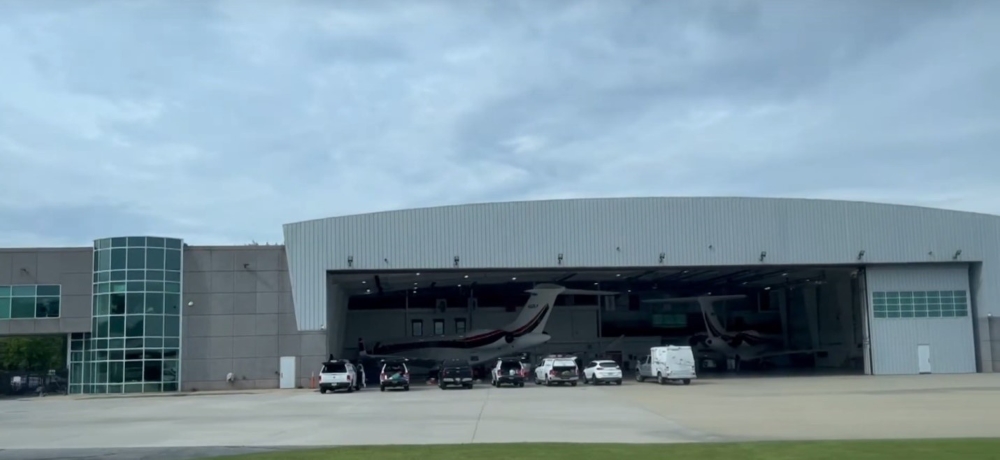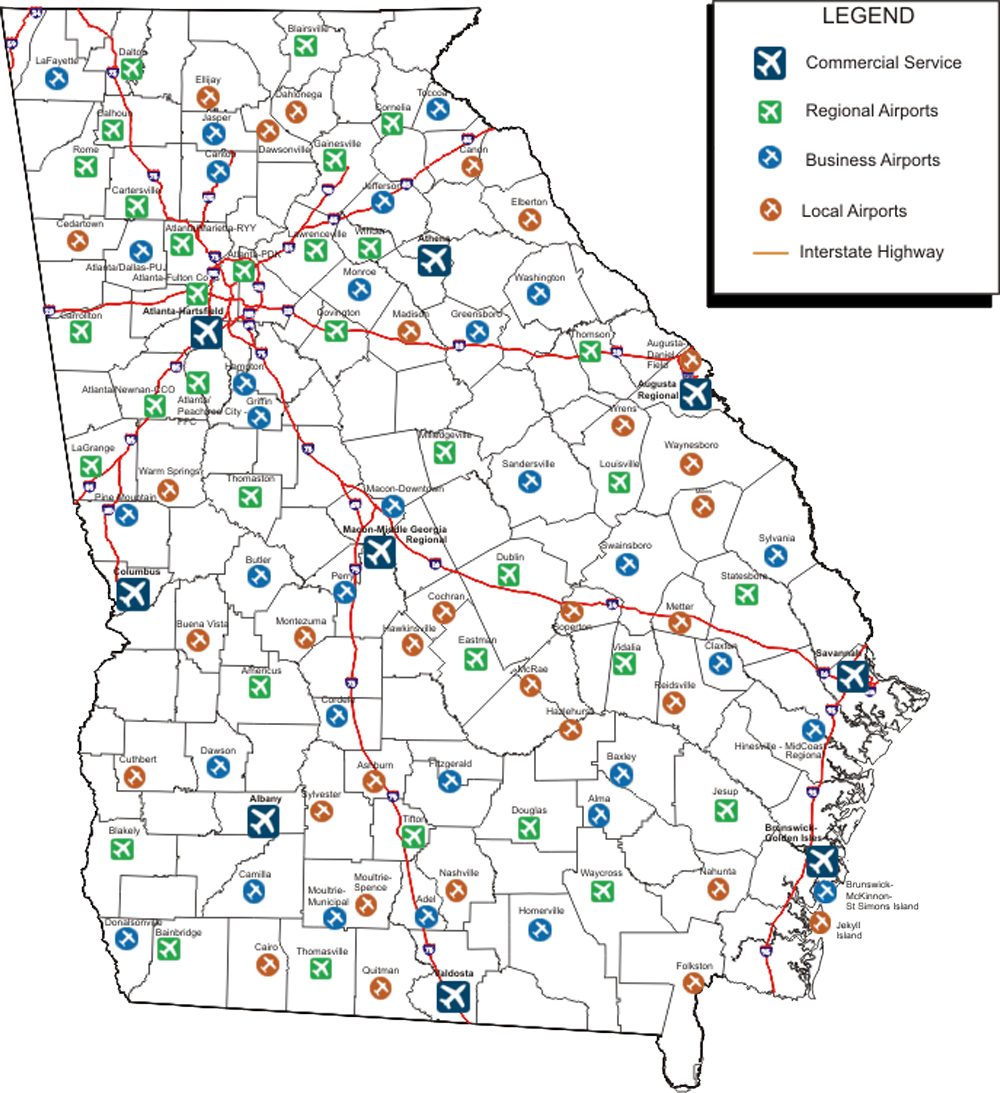
Photo by halbergman: Getty Images
With upgrades underway and more planned, Fulton County Executive Airport is preparing for global attention.
By Evan Secor
As Atlanta gets ready to host eight matches during the 2026 FIFA World Cup, Fulton County Executive Airport is preparing with some major upgrades not just for the event, but also to support the county’s longer-term economic growth.
The airport located just west of downtown Atlanta recently received a $6 million grant from the Federal Aviation Administration to support critical upgrades aimed at handling the expected increase in international traffic. The airport plans on a resurfacing of its runway, as well as a new customs facility. The improvements are part of a broader 20-year master plan to make the airport play a bigger role in corporate aviation.

“Corporate or personal jets make up about 90% of day-to-day operations”
– David Clark, Fulton County Director of Public Works, on activity at Fulton County Executive Airport
“The resurfacing project is going to happen between the second half of July and the first part of August,” says Fulton County Director of Public Works David Clark. “So that will be done well in advance. The customs facility is currently out for bid, and while it may or may not be finished in time for the World Cup, officials are working to make it happen.”
Right now, when international flights arrive at the airport, U.S. Department of Homeland Security officers have to drive the 15 miles from Hartsfield-Jackson International Airport to to meet the planes, and no one can disembark from the planes before they arrive. This is no longer sustainable in the growing economic climate of Atlanta. Clark said the airport already sees around 20 international flights each week, and that number is expected to rise. Corporate jets represent a significant portion of the airport’s traffic.
“Corporate or personal jets make up about 90% of day-to-day operations,” Clark says. The airport usually handles around 170 to 180 operations a day, but has seen up to 250 during major events like the Super Bowl, a figure the facility is likely to see again when the World Cup comes around.
Last year, Fulton County adopted a new 20-year Airport Master Plan, the first in more than 25 years. The plan outlines roughly $100 million in long-term improvements.
“These are really the first two projects out of a much longer list,” Clark says. One of the most ambitious pieces is a proposed runway extension from 5,900 feet to 7,000 feet which would allow larger aircraft to fly farther — including directly to parts of Europe — instead of flying from Fulton County to Hartsfield-Jackson to transfer to long-distance flights across the Atlantic, impacting the air and ground traffic at the busiest airport in the world. The county is also planning to expand its hangar capacity to 25 total hangars and expects a third fixed-base operator to begin operations soon.

A hangar at Fulton County airport with two jets inside.
Photo courtesy of Fulton County
The upgrades are part of a larger push in Georgia to improve airport infrastructure across the state. As part of the Bipartisan Infrastructure Law, the Airport Infrastructure Grant program has delivered over $13 million in federal funding to Georgia airports this year alone, with 28 grants announced in May going to such locations as Valdosta, Swainsboro, Griffin in Spalding County, Augusta and Heart of Georgia Regional Airport in Eastman, where Middle Georgia State University operates its School of Aviation.

A total of 28 FAA grants went to Georgia airports in May, following around $200 million in federal grants and support announced in 2024.
Map courtesy of Georgia DOT
Nationally, general aviation has a growing role. A February 2025 report produced by PwC for the General Aviation Manufacturers Association found that, including direct, indirect, induced, and enabled effects, “general aviation supported 1.3 million jobs, generated $107.5 billion in labor income (including wages and salaries and benefits as well as proprietors’ income), produced $339.2 billion in output and contributed $178.1 billion to GDP” in 2023. Georgia ranked No. 4 among the top 10 states by employment and by GDP contribution
Top 10 States, Total Economic Contribution of General Aviation,
Ranked by Employment, 2023 (Dollars in US$B)
| State | Total jobs | Total labor income(2) | Total output | Total contribution to GDP |
| California | 146,600 | $13.80 | $39.80 | $22.80 |
| Florida | 121,100 | $8.70 | $27.40 | $14.10 |
| Texas | 106,000 | $8.30 | $27.10 | $14.70 |
| Georgia | 56,800 | $4.70 | $16.30 | $8.40 |
| Arizona | 48,800 | $3.80 | $12.30 | $6.70 |
| Illinois | 46,400 | $4.30 | $12.30 | $6.60 |
| Ohio | 44,300 | $3.70 | $11.60 | $5.80 |
| New York | 41,600 | $4.50 | $11.60 | $7.00 |
| Kansas | 40,400 | $2.90 | $10.90 | $5.00 |
| Pennsylvania | 34,200 | $2.90 | $8.70 | $4.50 |
Source: PwC calculations using the IMPLAN modeling system
“Georgia’s airports are a key driver of job creation and economic competitiveness,” said U.S. Senator Jon Ossoff in a May 2025 news release that noted cumulative federal grants and other funding to Georgia airports reached $200 million in 2024. Senator Raphael Warnock added that the investment shows what can happen “when we reach across the aisle” to support long-term infrastructure improvements.
Fulton County, however, doesn’t receive FAA funds directly. As a “block grant state,” the money from the FAA comes through the Georgia Department of Transportation to the airport. Clark said that the relationship between the airport and GDOT has been important, especially with rising costs caused by tariffs and supply chain issues. “Our grant is fixed,” he says. “If it comes in an extra million dollars, we don’t get any additional money from the FAA, so we have to come up with that money ourselves.”

Jets on the runway at Fulton County Executive Airport.
Photo courtesy of Fulton County
The airport is part of a bigger redevelopment effort in the surrounding area, particularly along Fulton Industrial Boulevard. “Renew the District” is an initiative focused on rebranding the area as a positive space for modern business investment. In 2024, Site Selection ranked Fulton County the fourth-best county in the nation for economic development based on corporate facility project investments. The ranking reflects strong job creation, population growth and a steady increase in corporate investment across the region.
As companies like Mercedes-Benz and Prizepicks continue to consolidate operations in Atlanta and seek out business-friendly environments, Fulton County has put its name out there as one of the country’s top destinations for long-term growth. Samir Abdullahi, the county’s economic development director, said the airport is a major part of that vision.

“The reason why we won fourth-best county last year is that we are seeing so much growth in corporate consolidation and interest in the Atlanta region.”
– Samir Abullahi, Economic Development Director, Fulton County, Georgia
“This is a major asset for Fulton County as well as the metro Atlanta area,” he says. “The reason why we won fourth-best county last year is that we are seeing so much growth in corporate consolidation and interest in the Atlanta region.” He also commented on the airport’s increasingly high-end corporate visitors.
“A $100 million plane is not a rich guy plane — it’s a super-rich guy plane,” Abdullahi says. “And that’s what we deal with.”
With its upgraded infrastructure, long-term master plan and growing role in international business travel, Fulton County Executive Airport is quickly becoming a key hub not just for the World Cup but for the future of the ever-growing metro Atlanta area.

Evan Secor, shown here reporting from the SkillsUSA National Championships in Atlanta last week, is a summer editorial intern at Site Selection and a rising senior at Marist School in Atlanta. Watch for more of his work in an upcoming Site Selection Snapshot about the SkillsUSA results.